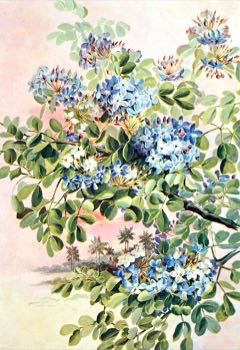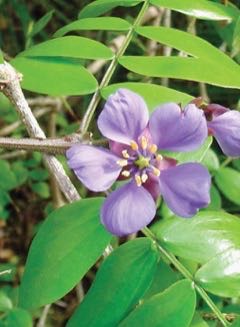 |
|
http://www.edibleplants.org |
 |
| Derek R. Artz - John C. Gifford Arboretum |
Translate this page:
Summary
Also known as Holywood Lignum-Vitae, Holywood or Guaiacum sanctum is a one of the flowering tree species that yield the valuable Lignum vitae wood. It is small and slow growing, reaching only about 7 m in height with a trunk diameter of 50 cm. It is evergreen and has an open, spreading crown. It is commonly found in Central America specifically in Costa Rica north to Mexico, Florida, and the Caribbean. It is the national tree of the Bahamas. The wood is used as a mild laxative and diuretic. It is use for tonsillitis, rheumatoid arthritis, chronic rheumatism, syphilis, skin diseases, and scrofula. The resin from the tree is used in some pharmaceutical preparations. The leaves can be used as a substitute for soap. The wood is extremely heavy and hard, and resistant to attack by decay fungi, termites, and marine borers. It is ideal for bearings, bushing blocks, pulley, turnery, etc.
Physical Characteristics

 Guaiacum sanctum is an evergreen Tree growing to 6 m (19ft) by 6 m (19ft) at a slow rate.
Guaiacum sanctum is an evergreen Tree growing to 6 m (19ft) by 6 m (19ft) at a slow rate.
See above for USDA hardiness. It is hardy to UK zone 10.
Suitable for: light (sandy), medium (loamy) and heavy (clay) soils and prefers well-drained soil. Suitable pH: mildly acid, neutral and basic (mildly alkaline) soils and can grow in very alkaline and saline soils.
It can grow in semi-shade (light woodland) or no shade. It prefers dry or moist soil. The plant can tolerate maritime exposure.
UK Hardiness Map
US Hardiness Map
Synonyms
Guaiacum guatemalense Planch. ex Rydb.
Plant Habitats
Edible Uses
References More on Edible Uses
Medicinal Uses
Plants For A Future can not take any responsibility for any adverse effects from the use of plants. Always seek advice from a professional before using a plant medicinally.
Acrid Alterative Antirheumatic Diaphoretic Diuretic Emmenagogue Laxative Stimulant
Although considered to be less useful than G. Officinale, in practice the wood and resin from this tree are used medicinally in much the same way as that species[418 ]. In particular, the wood is used as a mild laxative and diuretic. For tonsillitis it is given in powdered form. It is specially useful for treating rheumatoid arthritis, also in cases of chronic rheumatism and gout where it relieves the pain and inflammation between the attacks, and can lessen their recurrence if doses are continued. It acts as an acrid stimulant, increasing the heat of the body and promoting the circulation. When the decoction is taken hot and the body is kept warm, it acts as a diaphoretic, and if cool it works as a diuretic. It is also largely used for treating secondary syphilis, skin diseases and scrofula[418 ]. The resins obtained from wood, bark, leaves, and flowers are used in some pharmaceutical preparations[337 ]. The resin obtained from the heartwood is diuretic and mildly laxative[46 ].
References More on Medicinal Uses
The Bookshop: Edible Plant Books
Our Latest books on Perennial Plants For Food Forests and Permaculture Gardens in paperback or digital formats.

Edible Tropical Plants
Food Forest Plants for Hotter Conditions: 250+ Plants For Tropical Food Forests & Permaculture Gardens.
More

Edible Temperate Plants
Plants for Your Food Forest: 500 Plants for Temperate Food Forests & Permaculture Gardens.
More

More Books
PFAF have eight books available in paperback and digital formats. Browse the shop for more information.
Shop Now
Other Uses
Dye Resin Soap Wood
Other Uses: A brown to reddish-brown resin is obtained from the heartwood[46 ]. It is used for making small objects where strength, hardiness and weight are required[46 ]. The resin contains guaiaconic acid, guaiaretic acid, vanillin and guaiac yellow[46 ]. It is obtained by boring a log longitudinally then heating it in a sloping position. This causes the resin to melt and flow from the log[46 ]. The wood can also be chipped and then boiled in water, which causes the resin to float to the surface[46 ]. The leaves are sometimes used as a substitute for soap[418 ]. Lignum vitae is one of the heaviest of all woods, sinking under its weight instead of floating in water[309 ]. The heartwood is a dark greenish brown to almost black, becoming even darker after exposure to air and light[337 ]. It is readily distinguished from the narrow, pale yellow or cream-coloured sapwood[337 ]. The wood is extremely hard and heavy; very fine and uniform in texture with a heavily interlocked grain; oily, due to a resin content (guaiac content) that constitutes about 25% of the dry weight; turns and shapes well and takes a high polish; very resistant to attack by decay fungi, termites, and marine borers[337 ]. Because of the oily resins, the wood requires special surface treatments for satisfactory gluing. It does not require preservation due to its high guaiac resin content and high wood density[337 ]. The wood is used in bearings, bushing blocks, pulley sheaves, mallet heads, and turnery. It was once popular for use in the manufacture of bowling balls. Its most noted use is in bearings and bushing blocks for the propeller shafts of ships because of its self-lubrication and hardness[309 , 337 ].
Special Uses
References More on Other Uses
Cultivation details
A plant of the lowland moist tropics, where it is found at elevations up to 100 metres. It grows best in areas where annual daytime temperatures are within the range 22 - 28°c, but can tolerate 20 - 34°c[418 ]. It can be killed by temperatures of 1°c or lower[418 ]. It prefers a mean annual rainfall in the range 700 - 1,500mm, but tolerates 500 - 2,000mm[418 ]. Can be grown in full sun or partial shade on a wide variety of soils, including alkaline[309 ]. Plants will easily tolerate wet or dry soil, wind, and salt, making it an ideal choice especially for seaside plantings[309 ]. It grows well in shallow soils, particularly in limestone areas, well-drained low areas, low foothills subject to hot dry winds, and rocky limestone regions[337 ]. Prefers a pH in the range 5 - 7.5, tolerating 4.5 - 8[418 ]. Young trees commence flowering when about 6 - 8 years old[337 ].Flowering Time: Late Spring/Early Summer. Bloom Color: Light Blue Medium Blue. Spacing:15-20 ft. (4.7-6 m) 20-30 ft. (6-9 m). Drought-tolerant; suitable for xeriscaping.
References Carbon Farming Information and Carbon Sequestration Information
Temperature Converter
Type a value in the Celsius field to convert the value to Fahrenheit:
Fahrenheit:
The PFAF Bookshop
Plants For A Future have a number of books available in paperback and digital form. Book titles include Edible Plants, Edible Perennials, Edible Trees,Edible Shrubs, Woodland Gardening, and Temperate Food Forest Plants. Our new book is Food Forest Plants For Hotter Conditions (Tropical and Sub-Tropical).
Shop Now
Plant Propagation
Seed - best sown as soon as ripe. Immersing them in running water (at 20 °c) for 24 hours before sowing improves germination[337 ]. The seed is sown at a depth of 1 cm in containers of sandy compost. Germination begins 6 - 8 days after sowing and ends in 16 - 20 days[337 ]. Fresh seeds have 40 - 60% germination in nurseries[337 ]. When the seedlings are 6 cm tall, they are transferred to nursery bags. Seedlings are ready for outplanting 1 year after sowing, when they reach 30 - 40 cm in height[337 ]. Seeds can be stored for 1 month at 5 - 8 °C. They lose viability in less than 1 month if stored at ambient temperature and humidity[337 ]. Fruits must be collected from the soil very early in the morning to avoid seed predation by rodents[337 ]. The fruits are placed on the floor and dried for 7 days in the shade; later the fruit pericarp is removed with running water to extract the seeds. The seeds are then dried in the shade and stored in hermetic containers. Seeds average 20,000 per kg[337 ].
Other Names
If available other names are mentioned here
Guaiacum, holywood, lignum-vitae, floridapockenholts - Swedish, Lignum vitae, floridapockenholts, guaiac, guaiac resin, guaiaco, guaiacum, gum guaiac, holywood, lignum vitae, lignum-vitae, pau santo, resin guaiac,
Native Range
NORTHERN AMERICA: United States (Florida), Mexico (Campeche, Chiapas, Quintana Roo, Yucatán) SOUTHERN AMERICA: Hispaniola, Bahamas, Cuba, United States (Puerto Rico), Costa Rica, Guatemala, Honduras, Nicaragua, El Salvador
Weed Potential
Right plant wrong place. We are currently updating this section.
Please note that a plant may be invasive in one area but may not in your area so it's worth checking.
Conservation Status
IUCN Red List of Threatened Plants Status : Status: Endangered C2a

Growth: S = slow M = medium F = fast. Soil: L = light (sandy) M = medium H = heavy (clay). pH: A = acid N = neutral B = basic (alkaline). Shade: F = full shade S = semi-shade N = no shade. Moisture: D = dry M = Moist We = wet Wa = water.
Now available:
Food Forest Plants for Mediterranean Conditions
350+ Perennial Plants For Mediterranean and Drier Food Forests and Permaculture Gardens.
[Paperback and eBook]
This is the third in Plants For A Future's series of plant guides for food forests tailored to
specific climate zones. Following volumes on temperate and tropical ecosystems, this book focuses
on species suited to Mediterranean conditions—regions with hot, dry summers and cool, wet winters,
often facing the added challenge of climate change.
Read More
Expert comment
Author
L.
Botanical References
1
Links / References
For a list of references used on this page please go here
A special thanks to Ken Fern for some of the information used on this page.
Readers comment
| Add a comment |
|
If you have important information about this plant that may help other users please add a comment or link below. Only comments or links that are felt to be directly relevant to a plant will be included. If you think a comment/link or information contained on this page is inaccurate or misleading we would welcome your feedback at [email protected]. If you have questions about a plant please use the Forum on this website as we do not have the resources to answer questions ourselves.
* Please note: the comments by website users are not necessarily those held by PFAF and may give misleading or inaccurate information.
To leave a comment please Register or login here All comments need to be approved so will not appear immediately.
|
Subject : Guaiacum sanctum
|
|
|
|